Arms, titles, honours and styles of Arthur Wellesley, 1st Duke of Wellington
Arthur Wellesley, 1st Duke of Wellington KG, GCB, GCH, PC, FRS (c. 1 May 1769–14 September 1852) was an Anglo-Irish soldier and statesman and one of the leading military and political figures of the 19th century. His military career culminated at the Battle of Waterloo, where, along with Blücher, he defeated the forces of Napoleon Bonaparte. He was also twice Tory Prime Minister of the United Kingdom. During his life, Wellington received numerous honours, titles and awards throughout his career as a statesman and soldier.[1] These include awards, statues and monuments, as well as buildings and places named after him.

Sir Thomas Lawrence
Funeral
At his funeral Wellesley's style was proclaimed (laid out in the following order and format in the London Gazette):[2]
Arthur, Duke and Marquess of Wellington,
Marquess Douro, Earl of Wellington,
Viscount Wellington and Baron Douro,
Knight of the Most Noble Order of the Garter,
Knight Grand Cross of The Most Honourable Order of the Bath,
One of Her Majesty's Most Honourable Privy Council, and
Field Marshal and Commander-in-Chief of Her Majesty's Forces.
Field Marshal of the Austrian Army,
Field Marshal of the Hanoverian Army,
Field Marshal of the Army of the Netherlands,
Marshal-General of the Portuguese Army,
Field Marshal of the Prussian Army,
Field Marshal of the Russian Army,
and
Captain-General of the Spanish Army.
Prince of Waterloo, of the Kingdom of the Netherlands, Duke of Ciudad Rodrigo and Grandee of Spain of the First Class.
Duke of Victoria, Marquess of Torres Vedras, and Count of Vimiera in Portugal.
Knight of the Most Illustrious Order of the Golden Fleece, and of the Military Orders of St. Ferdinand and of St. Hermenigilde of Spain.
Knight Grand Cross of the Orders of the Black Eagle and of the Red Eagle of Prussia.
Knight Grand Cross of the Imperial Military Order of Maria Teresa of Austria.
Knight of the Imperial Orders of St. Andrew, St. Alexander Newski, and St. George of Russia.
Knight Grand Cross of the Royal Portuguese Military Order of the Tower and Sword.
Knight Grand Cross of the Royal and Military Order of the Sword of Sweden.
Knight of the Order of St. Esprit of France.
Knight of the Order of the Elephant of Denmark.
Knight Grand Cross of the Royal Hanoverian Guelphic Order.
Knight of the Order of St. Januarius and of the Military Order of St. Ferdinand and of Merit of the Two Sicilies.
Knight or Collar of the Supreme Order of the Annunciation of Savoy.
Knight Grand Cross of the Royal Military Order of Maximilian Joseph of Bavaria.
Knight of the Royal Order of the Rue Crown of Saxony,
Knight Grand Cross of the Order of Military Merit of Wurtemberg.
Knight Grand Cross of the Military Order of William of the Netherlands.
Knight of the Order of the Golden Lion of Hesse Cassel,
and
Knight Grand Cross of the Orders of Fidelity and of the Lion of Baden.
Arms

Wellington's arms were given an Augmentation of Honour of the union badge of the United Kingdom to commemorate his services. He bore, Quarterly, I and IV gules, a cross argent, in each quarter five plates of the same; II and III, Or, a lion rampant gules, armed and langued azure. For augmentation, an inescutcheon charged with the crosses of St. George, St. Andrew, and St. Patrick combined, being the union badge of the United Kingdom.[3]
Titles, honours and styles
Peerage of the United Kingdom
- Baron Douro of Wellesley in the County of Somerset – 26 August 1809[4]
- Viscount Wellington of Talavera, and of Wellington in the County of Somerset – 26 August 1809[4][5]
- Earl of Wellington – 28 February 1812
- Marquess of Wellington – 18 August 1812[6]
- Marquess Douro – 3 May 1814[5]
- Duke of Wellington – 3 May 1814[5]
His brother William selected the name Wellington for its similarity to the family surname of Wellesley, which derives from the village of Wellesley in Somerset, not far from that of Wellington.
Since he did not return to England until the Peninsular War was over, he was awarded all his patents of nobility in a single day.[7]
British and Irish honours
- Knight of the Bath – 1804[8]
- Privy Counsellor of Ireland – 28 April 1807
- Peninsular Cross with nine Medal bars for all campaigns, the only one so issued - 1810 (Displayed at Apsley House)
- Privy Counsellor of the United Kingdom – 1812[5]
- Knight of the Garter – 4 March 1813[5]
- Colonel of the Royal Regiment of Horse Guards – 1813-27
- Knight Grand Cross of the Bath (military) – 2 January 1815[9]
- Waterloo Medal – 1816 (Displayed at Apsley House)
- Governor of Plymouth – 1819-26
- Lord Lieutenant of Hampshire – 1820
- Colonel-in-Chief of the Rifle Brigade – 1820
- Lord High Constable of England – 1821, 1831, 1838
- Constable of the Tower – 1826
- Colonel of the Grenadier Guards – 1827
- Governor of Charterhouse School – 1828
- Lord Warden of the Cinque Ports – 1829
- Chancellor of the University of Oxford – 1834–52
- Master of Trinity House – 1837
- Honorary Member of the Institution of Civil Engineers – 1842[10]
- Fellow of the Royal Society – 1847
- Ranger of Hyde Park – 1847
- Ranger of St James's Park – 1850
The Duke of Wellington stood as godfather to Queen Victoria's seventh child, Prince Arthur, in 1850. Prince Arthur was also born on the first of May; and as a toddler, young Arthur was encouraged to remind people that the Duke of Wellington was his godfather.
International
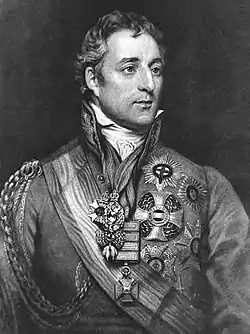
Noble titles
.svg.png.webp) Portugal:
Portugal:
- Count of Vimeira – 18 October 1811[6]
- Marquess of Torres Vedras – August 1812[6]
- Duke of Victoria – 18 December 1812[11]
.svg.png.webp) Spain: Duke of Ciudad Rodrigo, Grandee of the 1st Class – January 1812[6]
Spain: Duke of Ciudad Rodrigo, Grandee of the 1st Class – January 1812[6] Netherlands: Prince of Waterloo – 18 July 1815[5]
Netherlands: Prince of Waterloo – 18 July 1815[5].svg.png.webp) Belgium: Prince of Waterloo – 1831[5]
Belgium: Prince of Waterloo – 1831[5]
Honours
.svg.png.webp) Portugal: Knight Grand Cross of the Tower and Sword – 18 October 1811[11]
Portugal: Knight Grand Cross of the Tower and Sword – 18 October 1811[11].svg.png.webp) Spain:
Spain:
- Knight Grand Cross of the Military Order of St. Ferdinand – 11 April 1812[11]
- Knight of the Golden Fleece – 7 August 1812[11]
- Knight of the Order of Charles III – 1814[11]
- Knight Grand Cross of the Military Order of St. Hermenegild – 1817[11]
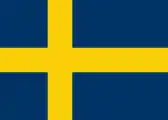 Sweden: Knight Grand Cross of the Sword, 1st Class – 26 February 1814[5][12][13]
Sweden: Knight Grand Cross of the Sword, 1st Class – 26 February 1814[5][12][13] Austria: Knight Grand Cross of the Military Order of Maria Theresa – 4 March 1814[5]
Austria: Knight Grand Cross of the Military Order of Maria Theresa – 4 March 1814[5] Russia:
Russia:
- Knight of St. George, 1st Class – 28 April 1814[5][12]
- Knight of St. Andrew – 8 July 1815[14]
- Knight of St. Alexander Nevsky – 8 July 1815[15]
- Knight of St. Anna, 1st Class – 8 July 1815[15]
.svg.png.webp) Prussia:
Prussia:
- Knight of the Black Eagle – 26 June 1815[16]
- Knight Grand Cross of the Red Eagle
 Denmark: Knight of the Elephant – 4 July 1815[17]
Denmark: Knight of the Elephant – 4 July 1815[17] Sardinia: Knight of the Annunciation, with Collar – 7 July 1815[18]
Sardinia: Knight of the Annunciation, with Collar – 7 July 1815[18] Netherlands: Knight Grand Cross of the Military William Order – 8 July 1815[19]
Netherlands: Knight Grand Cross of the Military William Order – 8 July 1815[19].svg.png.webp) Saxony: Knight of the Rue Crown – 27 July 1815[11]
Saxony: Knight of the Rue Crown – 27 July 1815[11].svg.png.webp) Baden:
Baden:
.svg.png.webp) Bavaria: Knight Grand Cross of the Military Order of Max Joseph – 1815[11]
Bavaria: Knight Grand Cross of the Military Order of Max Joseph – 1815[11]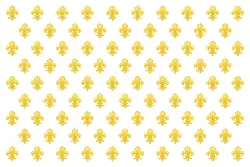 France: Knight of the Holy Spirit – 27 November 1815[11]
France: Knight of the Holy Spirit – 27 November 1815[11] Hesse-Kassel: Knight Grand Cross of the Golden Lion – 11 December 1815[20]
Hesse-Kassel: Knight Grand Cross of the Golden Lion – 11 December 1815[20] Württemberg: Knight Grand Cross of the Military Merit Order – 1815; with Blue Band – 1830[21]
Württemberg: Knight Grand Cross of the Military Merit Order – 1815; with Blue Band – 1830[21] Hanover: Knight Grand Cross of the Royal Hanoverian Guelphic Order – March 1816[11]
Hanover: Knight Grand Cross of the Royal Hanoverian Guelphic Order – March 1816[11].svg.png.webp) Two Sicilies:
Two Sicilies:
- Knight of St. Januarius – 16 July 1817[11]
- Knight Grand Cross of St. Ferdinand and Merit – 16 July 1817[11]
Military rank
The nations of Austria, Hanover, the Netherlands, Portugal, Prussian, Russia and Spain gave him their highest military rank:[2][11]
- Marshal-General of the Portuguese Army – 6 July 1809
- Captain-General of the Spanish Army – August 1809
- Field Marshal of the Hanoverian Army – 21 June 1813
- Field Marshal of the Army of the Netherlands – 1815
- Field Marshal of the Austrian Army – 15 November 1818
- Field Marshal of the Prussian Army – 15 November 1818
- Field Marshal of the Russian Army – 15 November 1818
Each nation presented him with a baton as a symbol of his rank (see Batons of Arthur Wellesley, 1st Duke of Wellington)
Styles
- In the United Kingdom
- The Hon Arthur Wesley (birth–1 May 1769)
- Ensign The Hon Arthur Wesley (7 March–25 December 1787)
- Lt The Hon Arthur Wesley (25 December 1787 – 30 June 1791)
- Capt The Hon Arthur Wesley (30 June 1791 – 30 April 1793)
- Maj The Hon Arthur Wesley (30 April–30 September 1793)
- Lt-Col The Hon Arthur Wesley (30 September 1793 – 3 May 1796)
- Col The Hon Arthur Wesley (3 May 1796 – 19 May 1798)
- Col The Hon Arthur Wellesley (19 May 1798 – 29 April 1802)
- Maj-Gen The Hon Arthur Wellesley (29 April 1802 – 1 September 1804)
- Maj-Gen The Hon Sir Arthur Wellesley KB (1 September 1804 – 8 April 1807)
- Maj-Gen The Rt Hon Sir Arthur Wellesley KB (8 April 1807 – 25 April 1808)
- Lt-Gen The Rt Hon Sir Arthur Wellesley KB (25 April 1808 – 4 September 1809)
- Lt-Gen The Rt Hon The Viscount Wellington KB (4 September 1809–May 1811)
- Gen The Rt Hon The Viscount Wellington KB (May 1811–28 February 1812)
- Gen The Rt Hon The Earl of Wellington KB (28 February–3 October 1812)
- Gen The Most Hon The Marquess of Wellington KB (3 October 1812 – 4 March 1813)
- Gen The Most Hon The Marquess of Wellington KG (4 March–21 June 1813)
- FM The Most Hon The Marquess of Wellington KG (21 June 1813 – 11 May 1814)
- FM His Grace The Duke of Wellington KG (11 May 1814 – 2 January 1815)
- FM His Grace The Duke of Wellington KG GCB (2 January 1815 – 14 September 1852)
- FM His Grace The Duke of Wellington KG GCB GCH (1816–14 September 1852)
- FM His Grace The Duke of Wellington KG GCB GCH FRS (1847–14 September 1852)
- In the Netherlands
- Zijne Doorluchtigheid de Prins van Waterloo (18 July 1815 – 14 September 1852)
- In Spain
- Excelentísimo señor Arthur Wesley, duque de Ciudad Rodrigo, Grande de España, Caballero de la Orden del Toisón de Oro (January 1812–14 September 1852).
- In Portugal
- Sua Excelência o Duque da Vitória (18 December 1812 – 14 September 1852)
Military promotions and dates of rank
Ranks up to Lieutenant Colonel were obtained by purchasing commissions, subject to minimum service periods. The army did not allow ranks from Colonel and above to be purchased, so they were obtained through promotion only.
- Commissions purchased[22]
- Gazetted an Ensign – 7 March 1787[23]
- Lieutenant – 25 December 1787[24]
- Captain – 30 June 1791[25]
- Major – 30 April 1793[26]
- Lieutenant-Colonel – 30 September 1793[27]
- Promotions[22]
- Colonel – 3 May 1796[28]
- Local Brigadier-General in Egypt (never activated; 17 July 1801)
- Major-General – 29 April 1802
- Lieutenant-General – 25 April 1808
- Field Marshal – 21 June 1813
Tributes
Statues, monuments and places

- Great Britain
- A statue of Wellington by the sculptor Carlo Marochetti stands in Woodhouse Moor park in Leeds, England. His boots have been painted red, presumably by local students.
- Royal Exchange Square, Queen Street in Glasgow, Scotland, has a statue of Wellington astride a horse, outside the Gallery of Modern Art. The statue does feature the bicorne cocked hat associated with him, but it is in his hand not on his head. The statue is often "defaced" by the placing of a traffic cone on Wellington's head.
- In 1838 a proposal to build a statue of Wellington resulted in the building of a giant statue of him on his horse Copenhagen, placed above the Wellington Arch at Constitution Hill in London directly outside Apsley House, his former London home. Completed in 1846, the enormous scale of the 40 ton, 30 feet (9 m) high monument resulted in its removal in 1883, and the following year it was transported to Aldershot where it still stands near the Royal Garrison Church.
- Wellington College, Berkshire, a senior boarding- and day-school in England, was built in memory of the Duke, under the orders of Queen Victoria.[30] To this day, all the boarding houses are named after the generals who fought alongside him at Battle of Waterloo, including Gebhard Leberecht von Blücher, Viscount Beresford, Sir Thomas Picton, Baron Lynedoch, and The Prince of Orange. The Queen laid the foundation stone in 1856 and inaugurated the School's opening on 29 January 1859. On 4 May 2007, the school held a memorial service for the Iron Duke at St Paul's Cathedral, London, to commemorate his birthday.
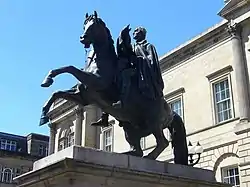
- A monument in St Paul's Cathedral, London where he is buried.
- Wellington Arch on Hyde Park Corner, London.
- Royal Exchange, London; this equestrian statue has "Erected June 16, 1844" inscribed into its plinth.
- A statue in the Great Hall of the Guildhall, London.
- Wellington Monument, London, at Hyde Park Corner, a colossal statue of Achilles by Richard Westmacott.
- Wellington Monument, in the Blackdown Hills, near Wellington, Somerset.
- Wellington Monument, Woodhall Spa, Lincolnshire.
- Wellington Monument, Baslow, Derbyshire.
- Wellington Statue, East End of Princes Street, Edinburgh.
- Wellington's Column in Liverpool.
- Duke of Wellington Commemorative Column, outside Stratfield Saye House, the Duke's Hampshire residence.
- Wellington College, in Crowthorne, Berkshire, the UK national monument to Wellington.
- A statue in Piccadilly Gardens, Manchester.
- Hong Kong
- Ireland
- The Wellington Testimonial was erected in the Phoenix Park, Dublin, from public subscriptions; As of 2015 it is the tallest stone obelisk in Europe.
- A monument in his birthplace in Trim, County Meath, Ireland.
- Wellington Road in the Ballsbridge area of Dublin.
- Wellington Road on the North side of Cork city.
- Wellington College Belfast in Northern Ireland, a Co-Educational Grammar School in Belfast, was named after Wellington. Wellington is also a Senior Boys' house at the Duke of York's Royal Military School, where, like Welbeck College, all houses are named after prominent military figures.
- Wellington Park in central Belfast. Running parallel to this street is Wellesley Avenue.
- Australia
- Mount Wellington, which overlooks Hobart, the capital of the state of Tasmania, Australia, is named after Wellesley. Additionally, Hobart also has Salamanca Place, a row of convict built warehouses which dominate the wharf area of the city, named after the Battle of Salamanca (also known as the Battle of Aripiles) which took place in July 1812. Behind Salamanca Place, which is now an arts, restaurant hub, plus the home of the Salamanca Market, is the riverside suburb of Battery Point. A walk through the area will see streets and crescents named after Napoleon, Waterloo and Arthur's Circus where colonial cottages front a small roundabout. And to add to the links, on Macquarie St sits the Duke of Wellington Hotel with imposing signage of the Iron Duke himself gazing down on all who pass beneath.
- Wellington Square in the Adelaide suburb of North Adelaide, South Australia, named for Wellington because he is credited with securing the passage of the South Australia Foundation Act through the British House of Lords.
- The former County of Douro in Victoria, Gipps District, was named in Wellington's honour and was bordered to the west by the County of Mornington. The former County of Douro was found on Victorian maps from 1845 and last appeared on a Victorian map in 1864. Further references to Wellington can be found locally in the naming of Waterloo Bay and Cape Wellington and Lake Wellington. The county was incorporated into the new County of Buln Buln in 1871. The County of Mornington proclaimed in 1849, is incidentally named after the title of Garret Wesley, 1st Earl of Mornington, Arthur Wellesley's father.
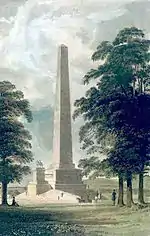
- New Zealand
- The capital city of New Zealand, Wellington, forms part of the Wellington Region, formerly part of Wellington Province. Greater Wellington has a private primary school named Wellesley College, and the central city had a private club, the Wellesley Club now merged with the senior Wellington Club founded December 1841 and New Zealand's oldest private club.[31]
- The city of Auckland has a central-city road named Wellesley Street. A volcanic cone and its associated suburb in the city bear the name Mount Wellington.
- Canada
- Wellington County, Ontario, the county surrounding the city of Guelph.
- The village of Wellington, a community located in Prince Edward County, Ontario.
- The town of Wellington on Vancouver Island, now a neighbourhood of Nanaimo, British Columbia, as well as Mount Wellington[32] which is located about 70 miles (113 km) north of the town.
- Wellington Street in Ottawa, the street upon which the Parliament Buildings, Canada's seat of government are located.[33]
- Both Wellington Street and Wellesley Street are principal downtown streets in Toronto, Ontario, Canada. Wellesley subway station takes its name from the street.
- Wellington railway station in Nanaimo, British Columbia
- Wellington Dyke, a large agricultural dyke across the Canard River in Kings County, Nova Scotia
- Wellington Gate and Wellington Barracks at CFB Halifax
- India
- The town of Wellington in the Nilgiri Hills district of Tamil Nadu, is the home of the Wellington Cantonment, a prestigious Indian military establishment, and college. It is near Coonoor on the Nilgiri Mountain Railway.
Military units
Wellington died in 1852 and in the following year Queen Victoria, in recognition of the 33rd foot regiment's long ties to him, ordered that the 33rd foot regiment's title be changed to The Duke of Wellington's Regiment.
Ships
HMS Duke of Wellington, a 131 gun first-rate ship of the line was named after the first Duke of Wellington. HMS Iron Duke, named after Wellington, was the flagship of Admiral Sir John Jellicoe at the Battle of Jutland in World War I, one of three so named in the Royal Navy.
Aircraft
Wellington is the only person to have the honour of having not one but two Royal Air Force bombers named for him - the Vickers Wellesley and the Vickers Wellington, and at a time when the convention was for British bombers to be named after landlocked cities.
Locomotives
Great Western Railways "Iron Duke" Class locomotives were named after Wellington, including one of the 1847 originals which was named "Iron Duke" and lent its name to the class. It was withdrawn in 1871, and a replica built in 1985 for the National Railway Museum to exhibit.[34]
Banknotes
The Duke of Wellington's picture featured on the reverse of Series D (Pictoral Series) £5 banknotes issued by the Bank of England (11 November 1971 – 29 November 1991), along with a scene from the Battle of Waterloo.[35]
Food and drink
Beef Wellington gets its name from the general and prime minister. Ironically, his favourite meat was mutton.
Wellington's likeness appears on the beer labels of the beer brewed by Wellington Brewery in Guelph, Ontario, and the beer "Iron Duke Strong Ale" was named in his honour.
Clothing
Wellington boots are a type of high, originally leather, boots.
The Wellington hat was a style of beaver-fur hat.
References
- Gifford, C.A. (1817). The Life of the Most Noble Arthur, Duke of Wellington. London: W.Lewis. p. 375.
- "No. 21388". The London Gazette. 6 December 1852. pp. 3563–3564.
- Brooke-Little, J.P., FSA (1978) [1950]. Boutell's Heraldry (Revised ed.). London: Frederick Warne LTD. p. 127. ISBN 0-7232-2096-4.
- "No. 16291". The London Gazette. 26 August 1809. p. 1342.
- Elliott, George (1816). The Life of the Most Noble Arthur, Duke of Wellington. London: J.Cundee. p. xiii–xiv.
- Gifford, C.A. (1817). The Life of the Most Noble Arthur, Duke of Wellington. London: W.Lewis. p. 100.
- Nafziger, George F. (2001). Historical Dictionary of the Napoleonic Era. Scarecrow Press. p. 301. ISBN 978-0-8108-6617-1.
- Shaw, Wm. A. (1906) The Knights of England, I, London, p. 176
- Shaw, p. 180
- Watson, Garth (1988). The Civils. Thomas Telford. p. 118. ISBN 0-7277-0392-7.
- James William Edmund Doyle (1886). "Wellington". The Official Baronage of England: Showing the Succession, Dignities, and Offices of Every Peer from 1066 to 1885. 3. London: Longmans Green and Co. pp. 615–620.
- Arthur Wellesley, first Duke of Wellington (1769–1852) – website historyhome.co.uk
- "Posttidningar, 30 April 1814, p.2". Archived from the original on 22 February 2014. Retrieved 15 October 2012.
- Almanach de la cour: pour l'année ... 1817. l'Académie Imp. des Sciences. 1817. p. 67.
- List of Knights of the Imperial Russian Orders for the Summer of Christmas 1827 (in Russian). 3. St. Petersburg: Imperial Academy of Sciences. 1828. p. 21.
- Liste der Ritter des Königlich Preußischen Hohen Ordens vom Schwarzen Adler (1851), "Von Seiner Majestät dem Könige Friedrich Wilhelm III. ernannte Ritter" p. 17
- Jørgen Pedersen (2009). Riddere af Elefantordenen, 1559–2009 (in Danish). Syddansk Universitetsforlag. p. 471. ISBN 978-87-7674-434-2.
- Cibrario, Luigi (1869). Notizia storica del nobilissimo ordine supremo della santissima Annunziata. Sunto degli statuti, catalogo dei cavalieri (in Italian). Eredi Botta. p. 99. Retrieved 4 March 2019.
- "Militaire Willems-Orde: Wellesly 1st Duke of Wellington KG GCB, Arthur" [Military William Order: Wellesley 1st Duke of Wellington KG GCB, Arthur]. Ministerie van Defensie (in Dutch). 8 July 1815. Retrieved 22 December 2020.
- Hessen-Kassel (1817). Kur-Hessischer Staats- und Adress-Kalender: 1817. Verlag d. Waisenhauses. p. 16.
- Württemberg (1831). Königlich-Württembergisches Hof- und Staats-Handbuch: 1831. Guttenberg. p. 35.
- Wellesley, Arthur (1837). Gurwood, John (ed.). The dispatches of Field Marshal the Duke of Wellington: During his various campaigns in India, Denmark, Portugal, Spain, the Low Countries, and France, from 1799 to 1818. Vol I. London: John Murray. p. xviii.
- "No. 12836". The London Gazette. 6 March 1787. p. 118.
- "No. 12959". The London Gazette. 26 January 1788. p. 47.
- "No. 13347". The London Gazette. 27 September 1791. p. 542.
- "No. 13542". The London Gazette. 29 June 1793. p. 555.
- "No. 13596". The London Gazette. 23 November 1793. p. 1052.
- "No. 13892". The London Gazette. 14 May 1796. p. 460.
- "No. 16510". The London Gazette. 3 August 1811. p. 1526.
- "Wellington College History". Archived from the original on 24 August 2007. Retrieved 8 August 2008.
- The Wellington Club
- "Mount Wellington". Bivouac.com. Retrieved 20 May 2009.
- "Wellington Street, Ottawa". National Inventory of Military Memorials. National Defence Canada. 16 April 2008. Archived from the original on 21 May 2014.
- "Broad-gauge 'Iron Duke' 4-2-2". Archived from the original on 19 May 2011. Retrieved 23 May 2011.
- "Withdrawn banknotes reference guide". Bank of England. Archived from the original on 10 June 2011. Retrieved 9 June 2011.
